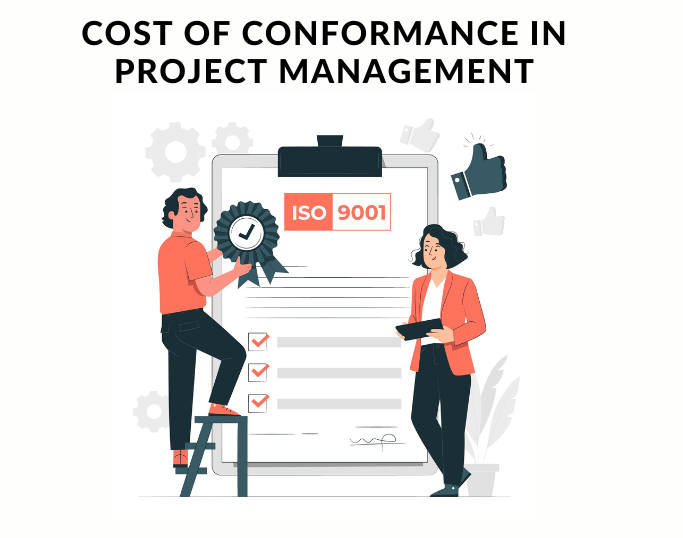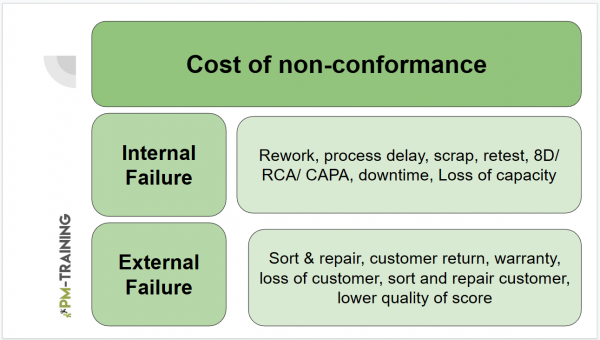
The cost of conformance is the money spent during the project to avoid failures. This includes the cost of quality assurance, training, and other activities that prevent problems. The cost of conformance is an essential concept in project management, as it can significantly impact the project’s overall success. In other words, it’s the cost of doing things right
One of the challenges in managing projects is ensuring that the project complies with all the relevant regulations and standards. This can often be costly, but it is essential to avoid any failures that could jeopardize the project.
The cost of conformance is the money spent during the project to avoid failures. This includes investing in activities and processes to ensure the product or service meets the required quality standards.
It is essential to consider the cost of conformance when allocating resources during the project.
In some cases, the cost of conformance may be higher than that of non-conformance, which should be considered when making decisions.It is an important consideration in any project, and it is essential to understand all the factors that can impact it.
Importance of Cost of Conformance
The best Project Managers are the ones who can complete their projects on time, within budget, and according to specifications. This is a difficult feat to achieve, requiring strict cost-conformance adherence.
Cost Conformance is essential to ensuring that all money spent during the project is necessary and avoidable failures.
This means that any money spent on the project must be within the approved budget and planned for in the project schedule.
Many factors such as project scope, timelines, and risks contribute to cost conformance. Organizations must carefully consider all of these factors to ensure project success.
In a nutshell, there are many benefits to adhering to cost-conformance.
- First, it ensures the project stays on track and does not exceed budget.
- Second, it allows for better communication between the Project Manager and the project sponsor.
- And finally, it ensures that the project is completed according to specifications.
Types Of Cost Of Conformance
There are two types of cost conformance in project management:
- Prevention Cost: Prevention costs are incurred to prevent the project from exceeding budget. They include training project managers on cost control methods, developing procedures, and setting up project management software to track costs. They also comprise all the costs incurred to keep the project free from defects.
- Appraisal Cost: Appraisal costs are incurred to determine whether the project is on track and are associated with inspecting project deliverables to check for anomalies. Also, it includes things like project audits, project reviews, and project evaluations
Project managers must understand the types of cost conformance and how they can impact the project’s overall budget.
Examples of Cost of Conformance
Many examples of cost conformance can improve a project’s chances of success.
- One example is documentation. Documentation of the project requirements, schedule, and budget is essential to cost conformance.
- Another example is inspections. Inspections of the site, equipment, and progress are essential to ensure the project proceeds as planned.
This plan includes periodic inspections and audits of project costs. When deviations from the budget are identified, corrective actions are taken to bring the project back into conformance. - Audits are also a key part of cost conformance. Audits of the project documentation, project schedule, and project budget can help identify any potential problems with the project.
- Finally, training is also an important part of cost conformance. Training of the project manager, project team, and project stakeholders can help ensure that everyone involved in the project understands the importance of cost conformance.
This training ensures that everyone on the team understands the process and knows how to properly document and track project costs.
Benefits Of Cost Of Conformance
While the cost of conformance may seem like an extra expense, it is often offset by the savings gained from improved project quality and efficiency.
- It is a key metric in project management, as it helps determine the optimal balance between the cost of ensuring quality and rectifying errors.
- Perhaps the most obvious benefit is that it can help to ensure that products and services are delivered to the required quality standards.
- By minimising the cost of errors and maximising the quality of the product or service, the CoC can help to improve customer satisfaction and reduce the risk of costly recalls.
- In addition, it can help reduce a project’s overall cost by preventing errors and rework.
By investing in cost of conformance, project managers can help to ensure that their projects are completed on time, within budget, and to the required standards.
Cost Of Conformance Vs Cost Of Non-Conformance

In any project, there are conformance costs associated with meeting quality standards and customer requirements, as well as non-conformance costs associated with defects and rework.
However the key differences between these two are the cost of conformance is the cost associated with meeting the requirements of the project, while the cost of non-conformance is the cost associated with not meeting the requirements of the project
The decision of whether to focus on conformance or non-conformance costs is a strategic one that should be made at the beginning of a project.
| Cost of Conformance | Cost of Non-Conformance |
|---|---|
| The cost of conformance is typically higher in the early stages of a project, as the project team is still working to establish the required processes and procedures. | The cost of non-conformance is typically higher in the later stages of a project, as the project team has already established the required processes and procedures but is not following them. |
| The cost of conformance is the cost incurred to prevent project failure. This includes the cost of quality assurance, project audits, and training. | When a project fails, the cost of non-conformance can be much greater than the cost of conformance. This is because the cost of non-conformance includes the cost of rectifying the project failure, which can be very expensive. |
- In order to choose the right process, it is important to have a clear understanding of the COQ. This includes the cost of Inspection, the cost of rework, and the cost of scrap.
The cost of conformance can be high, but the cost of non-conformance can be much higher. In order to minimize the cost of non-conformance, Six Sigma tools can be used. - Six Sigma is a quality control strategy that aims to reduce defective products by identifying and removing the causes of defects.
When choosing a manufacturing process, it is important to consider the cost of conformance and the cost of non-conformance. Six Sigma tools can be used to minimize the cost of non-conformance.
In conclusion, the cost of conformance is a preventative measure that should be taken in order to avoid the cost of non-conformance. The cost of conformance is an investment that can save a company a lot of money in the long run.
What are the best practices when doing Cost of Conformation?
There is no one-size-fits-all answer to this question, as the best practices for the cost of conformation in project management will vary depending on the nature of the project and the specific needs of the organization.
However, there are a few general best practices that can be followed in order to ensure that the cost of conformation is kept to a minimum.
Some of the best practices for cost of conformation in project management include:
- Defining the scope of the project upfront
- Creating a detailed project plan
- Working with a reputable and experienced project management company
- Having a clear understanding of the budget
- Tracking progress and costs regularly
Companies often overlook the costs associated with making their products and services compliant with quality standards. However, CoC should be given due consideration in any cost-benefit analysis of quality initiatives.
By following these best practices, organisations can minimize the cost of conformation and ensure that their projects are completed on time and within budget.
FAQs
What is the Cost of Conformance in Project Management?
The cost of conformance is the cost associated with making sure that a project meets all of the required specifications. This can include the cost of materials, labor, and other resources needed to complete the project.
What are the benefits of Cost of Conformance in Project Management?
The benefits of cost of conformance include increased project quality standards, improved project efficiency, and reduced project costs.
What are the key differences between Cost of Conformance and Cost of Non-Conformance?
In project management, the cost of conformance is the cost incurred to prevent project failure. This includes the cost of quality assurance, project audits, and training. The cost of conformance is a preventative measure that is taken to avoid the cost of non-conformance, which is the cost incurred when a project fails.
Why is Cost of Conformance important to consider in your project?
In simple terms, cost conformance ensures that the money spent during the project is within the budget. This is important because it helps organizations avoid project failures.
Leave A Comment